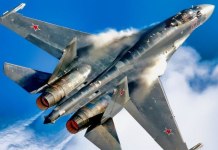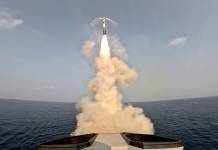Amid the race to built sixth-gen fighter jets by a host of countries including the US, UK, Russia & China, two crops of fifth-generation fighters still stand supreme as things stand in terms of modern aerodynamic designs and futuristic features— and guess what? Both of them belong to America.
Robotic Dog: Can This Four-Legged Machine Detect & Neutralize Threats To US Ground Troops?
The Maryland-based American aerospace juggernaut Lockheed Martin despite tough competition from Northrop Grumman and other aircraft manufacturers has helped the US reach the absolute summit of defense aviation with the development of the stealthy pair of F-35 Lightning and F-22 Raptors.
The two fighters are unarguably the most advanced when compared to any other fighter jet on the planet, however, what one often wonders is who will come out on top if both of them are pitched against each other.
F-22 Raptor vs F-35
While the F-35 is a single-seat, single-engine, all-weather stealth multirole fighters capable of performing ground attacks and air defense missions, the F-22 Raptor Fighter Jet is a single-seat, twin-engine, all-weather, fifth-generation, stealth, multi-role fighter.
The F-35 currently ranks as the most sought-after fighter on the planet, with nations like the United Arab Emirates (UAE) even ending decades of animosity with Israel to acquire the fighters.
However, the only reason why the Raptors do not trump the F-35s in sales is basically that the F-22s are not even in the running for a potential sale. Yes, that’s right. The United States has federal law over the export of the fighters with the Pentagon fearing that such incredible designs and technology could fall into the wrong hands.
This is the reason why despite a host of countries inquiring about the F-22s, only the US Air Force remains the primary user of the fighters, whereas the F-35s are still found in the squadrons of Israel, the UK, and Japan, and many more nations.
Moreover, the F-22 Raptors possess a set of unexplored unique features which have been classified by the US government, so much so that even the Raptor pilots are often not given the permission to use the full capabilities of the fighters in international exercises.
According to a report from the Government Accountability Office – “The F-22 units are often directed to participate in exercises as part of Air Force efforts to build relationships with partners,”
However, due to security concerns regarding exposing the F-22’s unique capabilities, F-22 pilots may be restricted from flying the aircraft the way they would in combat, according to Air Force officials. As a result, the value of the training is reduced and these types of exercises can result in the F-22 pilots developing bad habits that must be corrected in future training, according to Air Force officials.”
Most importantly, in terms of stealth technology, the F-22 Raptors are considered the stealthiest fighter jets on the planet with the aircraft boasting an even reduced cross radar section than that of the F-35s.
Despite the F-35s being loaded with state-of-the-art features, the fighters were built to carry out air-to-ground missions, and therefore do not stand a chance against the Raptors when it comes to dogfighting considering the US made the F-22s as an air-superiority fighter jet.
“The F-35 cannot match the F-22 as an air superiority fighter—it was never designed as such. The U.S. Air Force’s original plan was for the F-22 to be its high-end air superiority fighter while the F-35 was designed to be primarily an air-to-ground strike aircraft, but one which could defend itself,”
Thus, while the Raptor was designed with a very high degree of stealth, exceptional kinematic performance, and extreme maneuverability, the JSF was designed to be stealthy, networked, and have exceptional sensors, but with aerodynamic performance only comparable to an F-16 Fighting Falcon or F/A-18 Hornet” according to the National Interest.
The F-35 Joint Strike Fighter was built in three variants, one for each, the Air Force, the Marines, and the Navy, with the US Navy refusing to settle for anything other than the final Block 3F configuration.
While some variants possess the ability of vertical landing/takeoff along with other features, the Raptors still trump them when it comes to speed. According to Defense analyst, Colin Ritsick, writing for the Military Machine,
“When it comes to sheer speed, the F-35 just can’t keep up. But it wasn’t built to. The F-35, with its air-to-ground combat design, is not designed for breakaway speed. It has a top speed of 1.60 Mach, and less maneuverability than the F-22 in dogfight scenarios.
The F-22 can ramp it up all the way to 2.25 Mach. It climbs at a rate of 62,000 feet per minute whereas the F-35 climbs at 45,000 feet per minute.”
However, despite the mismatch in speed, the F-35s can still hold their own against non-stealthy fighters.
“The Air Force expects that the F-35, with its stealth and sensors, will be able to fill the gaps between flights of F-22s during a large-scale engagement. The F-35 does not have the sheer speed and altitude of the Raptor, but it does have excellent sensors and stealth, which does afford its decent capability against non-stealthy aircraft,” added the National Interest.
Moreover, even in terms of size – height, weight, wingspan, wing area, weight – the F-22 Raptor are a lot bigger than their younger brothers F-35s, with it becoming clearer that two siblings were never meant to battle each other and rather complement each other in a fight, which till date remains the plan of the United States.





